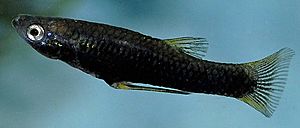Poeciliopsis sonoriensis facts for kids
Quick facts for kids Poeciliopsis sonoriensis |
|
|---|---|
 |
|
| male | |
| Conservation status | |
| Scientific classification |
The Yaqui topminnow is a type of fish that belongs to the family called Poeciliidae. Its scientific name is Poeciliopsis sonoriensis. Sometimes, people consider it a subspecies of the Gila topminnow, calling it P. o. sonoriensis. This fish naturally lives in Mexico and the United States. You can find some groups of them in Arizona in the United States. Many more groups still live in northern Sonora, Mexico.
What Does It Look Like?
The Yaqui topminnow has a long, slightly curved body. Its tail fin is either rounded or squared. Female Yaqui topminnows are usually about 3 to 4.5 centimeters long. Some females can grow even longer. Males are smaller, typically less than 2.5 centimeters long. The male's anal fin is shaped like a special organ. It uses this organ to fertilize the female's eggs.
Yaqui topminnows have some unique ways of reproducing. Unlike many fish, their eggs are fertilized inside the female. The female can store sperm from several males. She keeps it in a special part of her body. This allows her to fertilize eggs for a long time after mating. Females can also carry many different groups of babies at once. They give birth to live young fish instead of laying eggs.
During the time they breed, male Yaqui topminnows can turn completely black. They might act aggressively to find a mate. Other males might keep their normal color. These males try to mate without being noticed. Female Yaqui topminnows are tan or olive-colored. They have a light-colored belly and a dark stripe along their side.
This fish is very similar to the Gila topminnow (Poeciliopsis occidentalis). Sometimes, they are even considered the same species. You can tell the Yaqui topminnow apart by its mouth, which points slightly upwards. It also has a longer snout. The dark stripe on the female's body usually does not go past her front fins.
Life Cycle and Habitat
This fish prefers to live in shallow, warm water. It likes water that moves slowly. These areas often have lots of algae and plant bits. You will find them most often in marshes. They especially like marshes that are fed by natural springs. Yaqui topminnows eat tiny pieces of dead plants and animals. They also eat small bits of living plants and animals.
A female Yaqui topminnow can have 20 or more babies in one group. She can produce a new group of babies about every 20 days. In many places, these fish breed all year long. But in areas where the temperature changes a lot, they breed during warmer months. Most Yaqui topminnows do not live longer than one year.
Protecting the Yaqui Topminnow
The Yaqui topminnow lives in a small area. It is listed as a vulnerable species by the IUCN Red List. This means it is at risk of disappearing. The fish faces problems like losing its watery homes. It also has to compete with another fish called the western mosquitofish (Gambusia affinis). The western mosquitofish can be very aggressive.
Many Yaqui topminnows in the United States live in the San Bernardino National Wildlife Refuge. This is a special protected area. Here, the fish are safe from many dangers.
See also
 In Spanish: Guatopote de Sonora para niños
In Spanish: Guatopote de Sonora para niños


